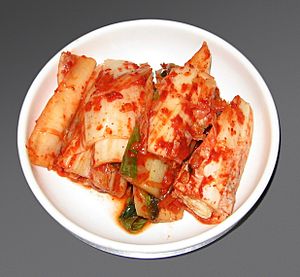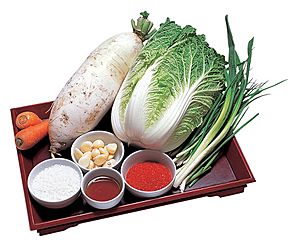Baechu-kimchi facts for kids
 |
|
| Type | Kimchi |
|---|---|
| Course | Banchan (side dish) |
| Place of origin | Korea |
| Associated national cuisine | Korean cuisine |
| Cooking time | 5 hours |
| Serving temperature | 4–10 °C (39–50 °F) |
| Main ingredients | Napa cabbage |
| 19 kcal (80 kJ) | |
| Korean name | |
| Hangul |
배추김치
|
|---|---|
| Revised Romanization | baechu-gimchi |
| McCune–Reischauer | paech'u-kimch'i |
| IPA | [pɛ.tɕʰu.ɡim.tɕʰi] |
Baechu-kimchi (배추김치), also known as cabbage kimchi or just kimchi, is a super important side dish in Korean cuisine. It's made by taking napa cabbage, salting it, adding lots of yummy seasonings, and then letting it ferment. Fermenting means it sits for a while, and good bacteria help change its flavor and make it last longer, kind of like how yogurt is made!
How Kimchi is Made
Baechu-kimchi is created by fermenting salted napa cabbages. Other ingredients include Korean radish, tasty vegetables, jeotgal (which is salted seafood), gochugaru (a special chili powder), and many other spices. Kimchi from the northern parts of Korea is usually milder and has more liquid. But if you try kimchi from the southern parts, it's often saltier and has a stronger, more intense flavor.
Preparing the Cabbages
First, the napa cabbages need to be salted. A special kind of salt called Korean brining salt is used. It has bigger grains than regular kitchen salt. This salt is not processed much, which helps bring out the best flavors in fermented foods like kimchi.
To start, the cabbages are washed, trimmed, and cut in half or quarters. Then, they are soaked in salty water for several hours. More salt is sprinkled between the cabbage leaves. After soaking, the cabbages are washed very well under running water to remove extra salt, and then they are drained.
Making the Fillings
Next, a thin, porridge-like paste is made by boiling a small amount of glutinous rice flour in water. This paste is the base for the kimchi seasoning. To it, gochugaru (chili powder), jeotgal (salted seafood), Korean radish, and other flavorful vegetables are added.
Some of the most common vegetables used are scallions, minced garlic, and ground ginger. You might also find garlic chives, Korean parsley, onions, carrots, and chilli peppers. The Korean radish is usually cut into thin strips, and the other vegetables can be chopped or minced.
Jeotgal, or salted seafood, adds a deep, savory flavor. In colder northern parts of Korea, fresh seafood might be used instead. Milder types of jeotgal like saeu-jeot (salted shrimp) are popular there. But in Southern Korea, people often use a lot of stronger myeolchi-jeot (salted anchovies). Sometimes, a liquid form of jeotgal, called aekjeot (fish sauce), is used. A little bit of sugar, honey, or fruit juice can also be added to balance the flavors.
Once the filling is ready, it's carefully packed in between each leaf of the prepared cabbages.
Fermentation Process
After the cabbages are filled, the kimchi is placed into a special Korean earthenware pot called an onggi or a regular container. It's covered and pressed down. Then, it's left to ferment at room temperature for a day or two.
In the past, kimchi was traditionally stored underground in these onggi pots. This helped keep it cool and ferment slowly. Today, most people store their kimchi in a special kimchi refrigerator or a regular refrigerator to keep it fresh and delicious for a long time.


